Play By Play: Chef Michael Jordan

He moves across the crowded floor swiftly and decisively. With confidence and grace, he quickly chops and dices through any obstacle in his way. On-lookers gasp as he turns up the heat and moves on to the next challenge like a flash in a pan. The rhythm between his teammates speeds into a crescendo and they all move together in the final play of the game. As the clock counts down to the last seconds, Chef Michael Jordan is finally able to take a time out and appreciate the work of his team as they place the finishing touches on the beautiful and savory meals they are about to serve their guests. High-fives abound, this team can rest assured they won this round.
Culinary specialists on board the aircraft carrier USS Nimitz (CVN 68) were treated to a special visit recently from Jordan during a three-week underway period in September. His mission while on board was to help Nimitz Sailors learn how to enhance the current menu of food served on board, offer new and different methods for cooking, and teach Sailors how to make new products from items already found on board.
Jordan’s resume is pretty extensive, though he didn’t always know he wanted to be a chef.
He got his start cooking as a line cook at a McDonald’s when he was 16 years old.
“Once you get a job as a cook, the easiest jobs for you to get somewhere else are cooking jobs,” Jordan said.
A few years and several restaurants later, Jordan’s mother showed him an advertisement she had seen for the Culinary Institute of America (CIA) in New York City.
“I was dumbfounded there were even schools for cooks,” Jordan said. “We went to New York and took a tour, and I knew it was what I wanted to do.”
However, not everyone in Jordan’s family was as excited as he was that he had finally found his calling.
“My grandfather was a judge, and a business owner,” Jordan said. “Being a career cook was not a popular choice at the time. When he found out what I was going to school for, he was horrified. He actually told me to join the Navy, in hopes it might give me a different career path.”
After graduating from CIA, Jordan found himself in New Orleans, where he got a job cooking for a little known chef with big aspirations: Emeril Lagasse.
“Emeril really can be credited with starting the whole chef craze that has been popular for the past few years,” Jordan said.
Jordan worked for Lagasse for seven years in New Orleans, and witnessed Lagasse’s success begin to boom.
“It was very confusing to see his business become famous,” Jordan said. “None of us were used to television cameras in the kitchen. But he had a vision, and he knew what he needed to do to get there.”
Jordan moved up the ladder in Lagasse’s business, going on to open a second restaurant in New Orleans, and eventually relocating to Las Vegas to open another location for his boss. He managed that location for a few years before he decided he wanted a change. Jordan and his wife, whom he had met at CIA, decided to open a restaurant.
“At 32 years old, I thought, if not now, then when,” said Jordan.
They ran Rosemary’s, a fine dining restaurant named after Jordan’s mother, for 12 years. During that time, Jordan received praise from the New York Times, Gourmet Magazine, Rachel Ray, and others.
“We were the number one rated restaurant in Las Vegas for a number of years,” Jordan said.
Unfortunately, even the great ones eventually have to bow out of the league. When the U.S. economy began to decline around the turn of the decade, so too did Las Vegas’.
“The town suffered,” Jordan said. “I was burnt out, tired, and not seeing my family. I said to myself, ‘if I’m not having any fun, then why am I still doing this?’”
Jordan closed up shop, and moved his family to Seattle, where he got a job teaching at the Seattle Culinary Academy (SCA). It was because of his job with the SCA that Jordan was able to come on board Nimitz.

“We originally tried to send some CSs to go to school, but because of issues with funding and the school’s and ship’s schedules, we weren’t able to make that happen,” said Nimitz’ food service leading petty officer, Culinary Specialist 1st Class Charles Blanton. “Instead of bringing our crew to him, we brought him to our crew.”
Master Chief Culinary Specialist Coasa Brannon, leading chief petty officer for the food service division, and acting food service officer, said the need for some outside instruction for her Sailors was obvious.
“Not every CS gets to go to ‘A’ school,” she said. “Many of our Sailors come to us as undesignated seamen, so the only training they get is on-the-job training.”
Brannon also stressed that it was important for her entire crew to be able to stay current and fresh with their skills.
“I don’t always get an opportunity to provide small group instruction, so it was good to bring [Jordan] in to do exactly that,” Brannon said.
Jordan said he jumped at the chance to come on board Nimitz. Though he wasn’t exactly sure what to expect, he said he tried hard to keep an open mind.
“This is not an easy environment to work in,” Jordan said. “But, every time I walk into a galley, there are people smiling, and positive attitudes. I think the fact that the leadership chose to bring me on board is a sign they want these guys to get better.”
One thing Jordan certainly wasn’t prepared for was the sheer volume of food being prepared on board Nimitz.
Having worked in many different corners of the cooking industry, Jordan thought he had seen it all before coming on board. Grabbing a 32oz ladle, Jordan shook his head and laughed.
“I had to take a picture of that to show my students,” he said. “I’ve never seen a ladle this big. But they need it here because they have to make so much food to serve all of the crew. It is impressive they can work in such bulk and at such speed as an organization.”
Jordan worked with CSs both individually and in small groups, giving demonstrations on knife skills, instructions on improving soups and sauce bases, and helping to prepare meals for distinguished visitors.
The atmosphere inside the wardroom III galley prior to a distinguished visitor meal was much like that of a locker room prior to a playoff game. The air is heavy, and Sailors skirt about the galley with furrowed brows, deep in thought. They work alone, or in small groups, prepping food to be cooked, or plates of salads for the guests. As the clock nears the starting time, the crew begins to gather around the main prep station.
“A lot of this trip has been about working together,” Jordan said. “Everybody has a role to play, a job to do – you have to work together to successfully serve a meal. If one person drops the ball, the whole meal can go wrong.”
Jordan spent several days working with CSs to plan menus, cook food, and prepare meals for the guests. One thing he really appreciated about working with Nimitz crew was their willingness to try new things, and the confidence they displayed in their own skills.
“I was talking with one CS the other day about cooking potatoes,” Jordan recounted. “I usually prepare mine one way, he does it another way. He explained that he has to cook them that way because of the amount of bulk he is cooking. After looking at it his way, I understood why he needed to do that.”
Jordan also saw several similarities between prepping for distinguished visitors and cooking in a high end civilian restaurant.
“There is an extreme amount of attention to detail here,” he said. “Also, everyone takes a lot of pride in their work, and shows a tremendous amount of versatility in their skills. The rhythm is very much like what happens in restaurants.”
Even with his extensive background in industrial kitchens, Jordan was unprepared for what he experienced in Nimitz’ largest kitchen.
“I think he was a little overwhelmed when he went into the aft galley,” Brannon said with a chuckle.
The aft galley on board Nimitz serves roughly 3,000 Sailors daily. Much of the food that is served there is premade, processed food. According to both Jordan and Brannon, though, that doesn’t mean CSs can’t put some TLC into the food they prepare.
“I’m not here to change the program,” Jordan said. “I’m here to help these guys learn how to manipulate processed food and how to understand various techniques in order to be creative.”
Brannon agreed that creativity is a staple ingredient in cooking, whether it be for a few people, or a large organization.
“When you cook, you add together a little bit of your personality, your skills, and some love,” Brannon said.
“That gives you an opportunity to take pride in your work, and makes the food better for the Sailors you are serving.”
Blanton said he thinks Jordan’s visit gave some of his Sailors some encouragement to continue to push themselves and their skills to the next level.
“For some of the crew, the Navy may be a stepping stone,” Blanton said. “These guys might read Chef Jordan’s biography, and talk to him a bit, and they might be able to see someone whose success they can replicate.”
Blanton also said that successful CSs can inspire the entire crew to do a good job.
“All Sailors come through the line three to four times a day,” he said. “If the food or service they receive is not good, those Sailors won’t be productive – they’ll be thinking about how bad the food was, or how hungry they are. The work we do allows others to focus on their own work.”
Some of Nimitz CSs have prior cooking experience, Brannon said. For them, Jordan’s visit was especially meaningful.
“I think it gave them the opportunity to ‘walk the walk’ and ‘talk the talk’ with someone who understood their language,” she said. “They were able to dust off some of the skills they don’t get to use very often, and display them for someone who could really appreciate that talent.”
Though Jordan has returned to his work at SCA, Nimitz food service division is continuing its commitment to excellence.
“We have been able to secure training for every one of our CSs for next year,” Brannon said.
Training will come in the form of “A” and “C” schools, and even possibly, some classes at SCA for others.
“He did an outstanding job,” Brannon said of Jordan. “His presence reinvigorated our crew, and gave them some confidence and skills to improve on a job they already are committed to doing well.”
TIME OUT: WITH MICHAEL JORDAN
Q: How do you feel about Kobe…beef?
MJ: I love Kobe beef. I love the fact America is finally producing our own type of Kobe (down in Oregon). Kobe is honestly the premier cut on the market.
Q: What is your favorite dunk…sauce?
MJ: Hugo’s Texas Bar-B-Q Sauce. It’s my late father-in-law’s recipe. He was an engineer in the oil fields of Texas – a real ‘larger than life’ sort of character. When my wife and I opened Rosemary’s we served his sauce in honor of him.
Q: How do you get yourself into ‘the zone’ before a big ‘game?’
MJ: I don’t do it as much anymore, but when I first started working for Emeril, I worked at the grill station, which was the hottest (and hardest) place to be. Before a big night, I used to go into the bathroom and just stare myself down in the mirror and really hype myself up. I also really try to give myself attainable goals. I don’t just say, ‘I want to cook a great meal.’ I give myself something measureable to work toward. And, of course, I try to get eight hours of sleep the night before, I eat a good breakfast and drink lots of water. I try to focus on taking care of myself.
Q: Who were some of the star players you looked up to when you were still a rookie?
MJ: Oh, there are a lot. Emeril, Charlie Trotter and Norman Van Aiken were best friends who used to cook together all the time. I admired their camaraderie and professionalism. They taught me how to develop my palate and trust myself.
Also, Julia Child and James Beard. I really looked up to their attention to detail and pursuit of excellence.
Q: Why do you play?
MJ: I cook for others. I play to give – cooking is an act of giving, without any expectation of getting anything in return. I also cook for the traditions. I have a responsibility to pass on what I know to the next generation and others after that.

Story and photos by MC3(SW/AW) Siobhana McEwen

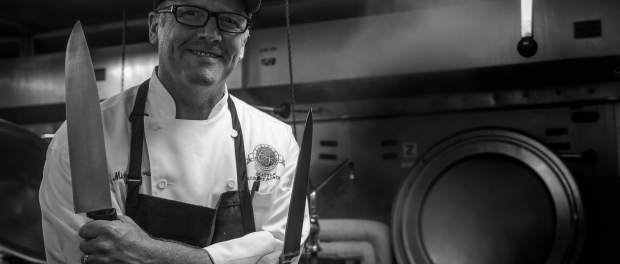
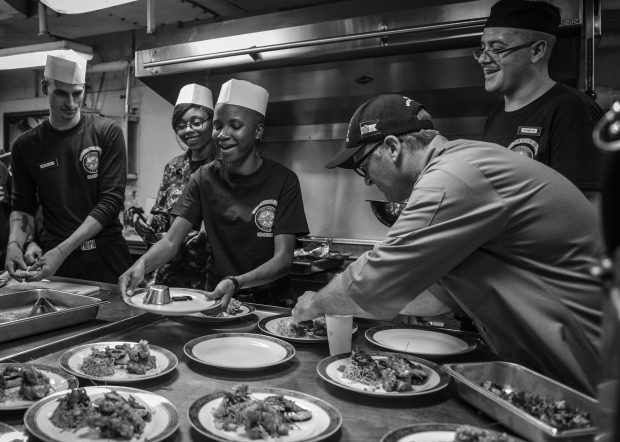
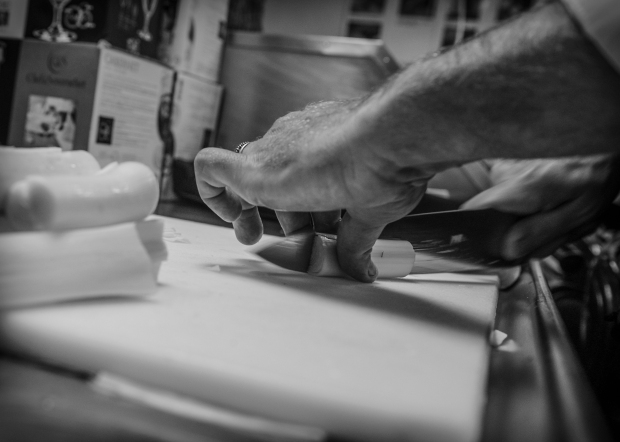
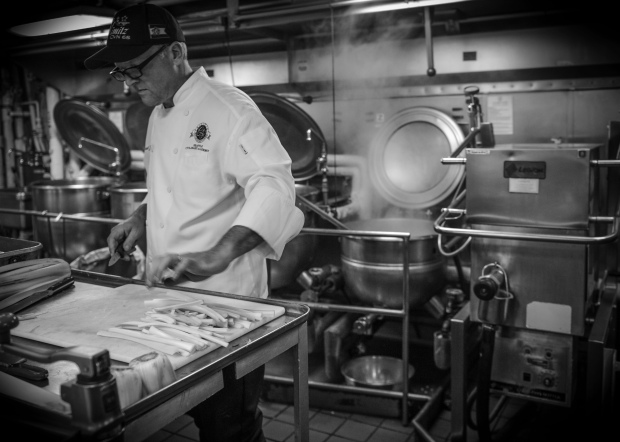
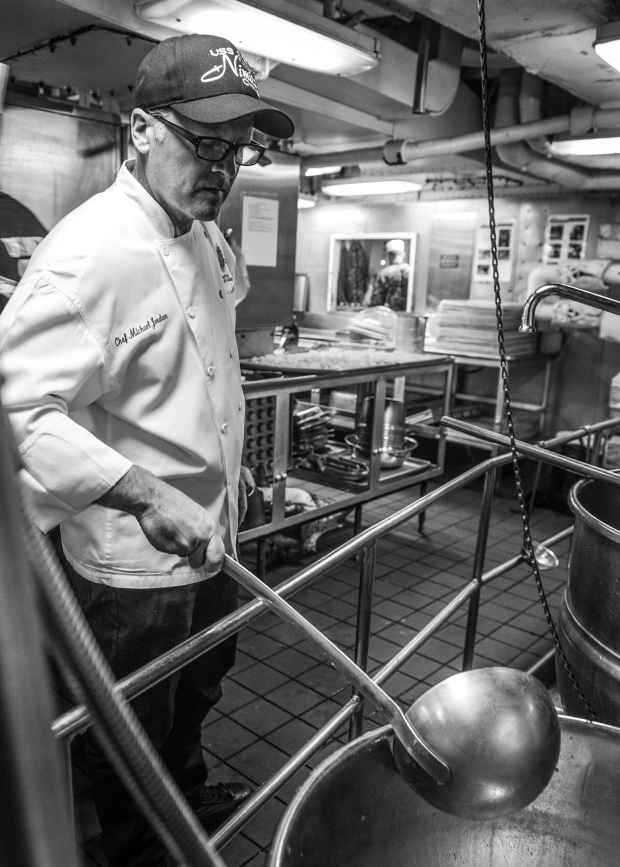
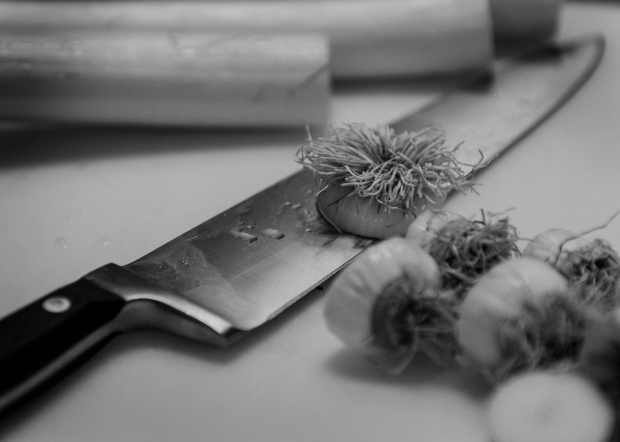
Leave a comment